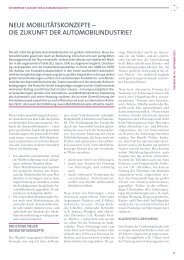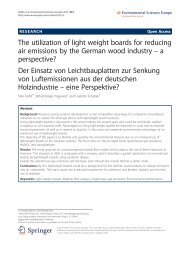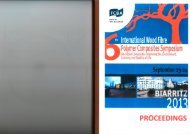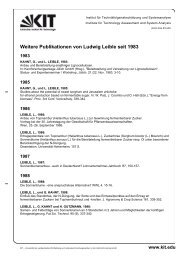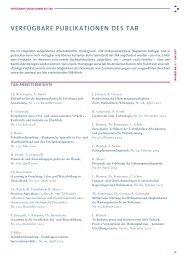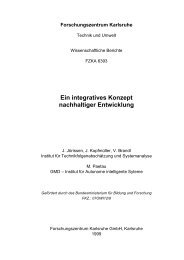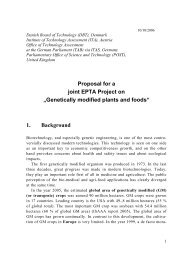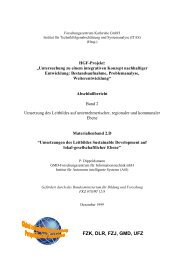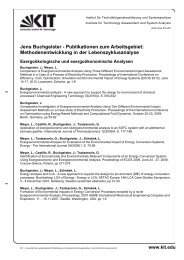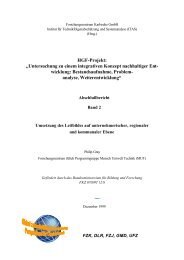Results: RFID and Identity Management in everyday life - ITAS
Results: RFID and Identity Management in everyday life - ITAS
Results: RFID and Identity Management in everyday life - ITAS
Create successful ePaper yourself
Turn your PDF publications into a flip-book with our unique Google optimized e-Paper software.
to the CBP commercial purposes alone are no reason to store <strong>and</strong> use data. The question hereby is whether<br />
travellers have a fair opt <strong>in</strong> or opt out choice.<br />
Accord<strong>in</strong>g to the WBP users explicitly have to agree with the collection <strong>and</strong> storage of travell<strong>in</strong>g data [4]. But<br />
it looks like travellers don’t always have a clear choice. In case of the discount card of the NS for example<br />
the users agree with the collection of data when they first use the card. Consumer organizations say that this<br />
is the wrong way round; the st<strong>and</strong>ard should be that travellers don’t give permission unless they actively say<br />
TLS can use their data. The CBP also warned aga<strong>in</strong>st personal cards that are (temporarily) cheaper than<br />
anonymous cards [41]. And f<strong>in</strong>ally there are questions concern<strong>in</strong>g the storage term of the gathered data.<br />
The companies have to respect the law on the protection of personal data (Wet Bescherm<strong>in</strong>g<br />
Persoonsgegevens, WBP). But the NS <strong>and</strong> TLS say they <strong>in</strong>terpret this law differently than the CBP does <strong>and</strong><br />
still say they can store <strong>and</strong> use the data. The m<strong>in</strong>ister of transport still hopes to solve the issue [39, 40, 50].<br />
Costs<br />
Another problem occurs with the different possibilities of the OV-chip card. This card can be loaded with a<br />
certa<strong>in</strong> product (like a tra<strong>in</strong> ticket), which is called ‘specify<strong>in</strong>g beforeh<strong>and</strong>’. Another option is to check <strong>in</strong> with<br />
the card at the entrance <strong>and</strong> check<strong>in</strong>g out at the exit, known as ‘specify<strong>in</strong>g while travell<strong>in</strong>g’. Consumer<br />
organizations f<strong>in</strong>d it unacceptable that ‘specify<strong>in</strong>g while travell<strong>in</strong>g’ is go<strong>in</strong>g to be more expensive than<br />
‘specify<strong>in</strong>g beforeh<strong>and</strong>’ namely 10 to more than 100 percent [13]. Then most travellers will specify their<br />
journey beforeh<strong>and</strong> thus limit<strong>in</strong>g the advantages of the OV-chip card.<br />
Accord<strong>in</strong>g to calculations the costs of travell<strong>in</strong>g <strong>in</strong> rush hours will rise with 10% while travell<strong>in</strong>g outside these<br />
hours will cost 20% less [12]. Consumer organizations protest aga<strong>in</strong>st this because most travellers have no<br />
choice but to travel dur<strong>in</strong>g rush hours [14].<br />
Apart from travell<strong>in</strong>g costs there are also costs to obta<strong>in</strong> a chip card. Some members of parliament <strong>and</strong><br />
different consumer organizations like Rover f<strong>in</strong>d the price of the card (€7,50) too high [17, 20, 25, 26]. This<br />
resulted <strong>in</strong> a temporarily lower<strong>in</strong>g to €3,75 [38]. But accord<strong>in</strong>g to the consumer organizations a temporarily<br />
low price is <strong>in</strong>sufficient [17]. Members of the parliament also warned that the travell<strong>in</strong>g costs should not rise<br />
with the <strong>in</strong>troduction of the OV-chip card, the m<strong>in</strong>ister agrees [28]. Another issue is that TLS profits from the<br />
<strong>in</strong>terest from the balance on the cards, this could be used to lower the price [36].<br />
Consumer organizations further want to use more possibilities of the OV-chip card to maximize its utility <strong>and</strong><br />
acceptance of the travellers (lockers, station stores, park<strong>in</strong>g, tra<strong>in</strong> taxi) [13]. But for now it is unclear what the<br />
possibilities are. The website of the OV-chip card even states that mobile phones <strong>and</strong> other <strong>RFID</strong>-cards can<br />
cause malfunction<strong>in</strong>g of card readers [9]. Although there have been a great number of pilots worldwide on<br />
the use of <strong>RFID</strong> systems the use <strong>in</strong> practice is first to been seen.<br />
An evaluation showed that 75% of the travellers that use the OV-chip card say the system works sufficient,<br />
25% th<strong>in</strong>ks there are to many problems with malfunction<strong>in</strong>g of the system, limited use <strong>and</strong> costs that are<br />
expected to rise [18]. In June 2006 the parliament <strong>and</strong> consumer organizations still have worries about the<br />
privacy <strong>and</strong> the costs of the system <strong>and</strong> costs of travell<strong>in</strong>g but eventually lets the m<strong>in</strong>ister cont<strong>in</strong>ue the<br />
project [38, 40].<br />
Reactions on the <strong>in</strong>ternet show that people are not conv<strong>in</strong>ced about the use of the OV-chip card system.<br />
Test travellers say travell<strong>in</strong>g is more expensive with this card <strong>and</strong> the entrance to the public transport is<br />
slower [53]. Other test travellers <strong>in</strong> Rotterdam praise the system because it is easy to use because you just<br />
have to wave your card before a reader [54]. So the test travellers have different op<strong>in</strong>ions about the use of<br />
the OV-chip card. But many are scared by the idea that more <strong>and</strong> more <strong>in</strong>formation about their person <strong>and</strong><br />
whereabouts are registered [54]. Some especially criticise the lack of choice; when us<strong>in</strong>g the public transport<br />
regularly - <strong>and</strong> therefore use a discount card or a subscription - they cannot travel anonymous [54]. There<br />
are also fears of function creep; that the police soon will get access to all travel data <strong>and</strong> that the storage<br />
term will be extended [54]. And others worry about the security of the travel data, especially when this data<br />
will be accessible over the <strong>in</strong>ternet [54]. Further there are concerns about the use of the data for commercial<br />
purposes like advertisements [55].<br />
Because of these worries people already search for ways to underm<strong>in</strong>e the system; for example by<br />
exchang<strong>in</strong>g OV-cards [54]. Other contributors on the <strong>in</strong>ternet fantasize about hack<strong>in</strong>g the chip [55].<br />
Another reaction came from a person who is afraid that the use of the OV-chip card for small payments <strong>in</strong><br />
c<strong>in</strong>ema’s, park<strong>in</strong>g lots, etc. (like the system <strong>in</strong> Hong Kong) comb<strong>in</strong>ed with an automated reload function of<br />
the card balance will cause users to run <strong>in</strong>to debts [55]. And f<strong>in</strong>ally there are people worried that the OV-card<br />
system is to complex for a large group of people, especially elderly [56].<br />
Personal experiences of our researchers [57]<br />
59



